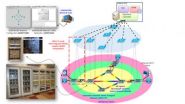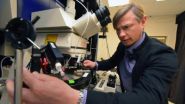New drug development, no matter the disease, is a slow, expensive, and risky process. Thus, innovative techniques to study and assess the possibilities of already-existing drugs for different diseases can be used to alleviate the traditional burdens of cost and time. Detailed in their new article in Biological Psychiatry, researchers from the University of Washington, led by Dr. Brian Kraemer, have developed an exciting new approach to screening potential new treatments for Alzheimer's disease using C. elegans, a small transparent worm.
Their focus was on tau, a protein involved in maintaining brain cell structure. In Alzheimer's disease and related disorders, tau protein becomes abnormally modified and forms clumps of protein called aggregates. These aggregates are a hallmark of the dying nerve cells in Alzheimer's disease and other related disorders. Diseases with abnormal tau are called tauopathies.
Dr. Kraemer's lab previously developed a worm model for tauopathy by expressing human tau in C. elegans nerve cells. This model has behavioral abnormalities, accumulates abnormal tau protein, and exhibits loss of nerve cells—all of which are general features of Alzheimer's disease.
Using their worm model for this study, they screened a library of 1,120 drugs approved for human use and tested each at three different concentrations to identify compounds that suppress the effects of abnormal tau aggregation.
"We have identified six compounds capable of reliably alleviating tau induced behavioral abnormalities in our C. elegans model for tauopathy. In a human cultured cell model for abnormal tau protein, we have also seen that azaperone treatment can decrease the amount of abnormal tau," said Kraemer.
Azaperone, an antipsychotic drug, normally binds to certain dopamine receptors found in nerve cells. They demonstrated that removing those receptors in either C. elegans or human cells has the same effect as azaperone treatment, indicating that azaperone and related drugs should alter abnormal tau accumulation. Other antipsychotic drugs also have a similar effect to azaperone.
Tests of these compounds for anti-tau properties are now underway in existing mouse models of Alzheimer's disease.
"This study is an exemplary instance of how a simple C. elegans model system may be used to rapidly screen drugs for diseases and evaluate mechanism of action," said Drs. Sangeetha Iyer and Jonathan Pierce-Shimomura, authors of a commentary that accompanies this article.
Dr. John Krystal, Editor of Biological Psychiatry, agrees and added: "Studying the worm, C. elegans, has already provided us with fundamental insights into how the brain develops. The new approach described by McCormick and colleagues suggests that this animal model may be a powerful new approach to studying novel treatments that prevent its decline."
###
The article is "Dopamine D2 Receptor Antagonism Suppresses Tau Aggregation and Neurotoxicity" by Allyson V. McCormick, Jeanna M. Wheeler, Chris R. Guthrie, Nicole F. Liachko, and Brian C. Kraemer (doi: 10.1016/j.biopsych.2012.08.027). The commentary is "Worming Our Way to Alzheimer's Disease Drug Discovery" by Sangeetha Iyer and Jonathan T. Pierce-Shimomura (doi: 10.1016/j.biopsych.2012.12.026). Both appear in Biological Psychiatry, Volume 73, Issue 5 (March 1, 2013), published by Elsevier.
Notes for Editors
Full text of the articles is available to credentialed journalists upon request; contact Rhiannon Bugno at +1 214 648 0880 or Biol.Psych@utsouthwestern.edu. Journalists wishing to interview the authors may contact the Public Affairs Office of VA Puget Sound Health Care System at PublicAffairsPugetSound@va.gov.
The authors' affiliations, and disclosures of financial and conflicts of interests are available in the article.
John H. Krystal, M.D., is Chairman of the Department of Psychiatry at the Yale University School of Medicine and a research psychiatrist at the VA Connecticut Healthcare System. His disclosures of financial and conflicts of interests are available here.
About Biological Psychiatry
Biological Psychiatry is the official journal of the Society of Biological Psychiatry, whose purpose is to promote excellence in scientific research and education in fields that investigate the nature, causes, mechanisms and treatments of disorders of thought, emotion, or behavior. In accord with this mission, this peer-reviewed, rapid-publication, international journal publishes both basic and clinical contributions from all disciplines and research areas relevant to the pathophysiology and treatment of major psychiatric disorders.
The journal publishes novel results of original research which represent an important new lead or significant impact on the field, particularly those addressing genetic and environmental risk factors, neural circuitry and neurochemistry, and important new therapeutic approaches. Reviews and commentaries that focus on topics of current research and interest are also encouraged.
Biological Psychiatry is one of the most selective and highly cited journals in the field of psychiatric neuroscience. It is ranked 5th out of 129 Psychiatry titles and 16th out of 243 Neurosciences titles in the Journal Citations Reports® published by Thomson Reuters. The 2011 Impact Factor score for Biological Psychiatry is 8.283.
About Elsevier
Elsevier is a world-leading provider of scientific, technical and medical information products and services. The company works in partnership with the global science and health communities to publish more than 2,000 journals, including The Lancet and Cell, and close to 20,000 book titles, including major reference works from Mosby and Saunders. Elsevier's online solutions include ScienceDirect, Scopus, Reaxys, ClinicalKey and Mosby's Nursing Suite, which enhance the productivity of science and health professionals, and the SciVal suite and MEDai's Pinpoint Review, which help research and health care institutions deliver better outcomes more cost-effectively.
A global business headquartered in Amsterdam, Elsevier employs 7,000 people worldwide. The company is part of Reed Elsevier Group PLC, a world-leading provider of professional information solutions in the Science, Medical, Legal and Risk and Business sectors, which is jointly owned by Reed Elsevier PLC and Reed Elsevier NV. The ticker symbols are REN (Euronext Amsterdam), REL (London Stock Exchange), RUK and ENL (New York Stock Exchange).
END

